Calibres we choose
So, the calibers of the guns ... But what could be the minimum caliber to say for sure: this is a gun, and this is a machine gun? Experts have been arguing about this for a long time and decided this: all that is less than 15-mm is a machine gun, but all that is more is a gun! Since the most common caliber of aircraft cannons during the Second World War was 20-mm, therefore, the smallest-caliber gun will have a bore diameter equal to 20 mm, although there are exceptions. The most famous is the Japanese anti-tank gun, created in the early 30s of the 20th century. just such a caliber. It was the heaviest anti-tank gun in the world, but since it was still a “gun”, two people could carry it. Large caliber - this is a great armor penetration, however, in general, it did not justify itself, since the speed of its armor-piercing bullet was not very high, and this is a very important indicator for this type of weapon!
But the 20-mm automatic aircraft cannon are very much known, and the most famous of them is the Vulcan automatic cannon, developed in the USA for arming airplanes and helicopters, as well as anti-aircraft artillery systems on armored personnel carriers and ships. In the second film about the Terminator, you can see how such systems operate, although in reality a person cannot withstand the impact of such weapons.
And not only guns, but even a machine gun! “You have 20,” our military decided, having become acquainted with German aircraft guns during the Great Patriotic War, “but we will have 23-mm!” And such a gun with a heavier, and therefore more destructive projectile, VY brand was created and stood on many of our aircraft, including attack aircraft IL-2. In other countries, aircraft and anti-aircraft guns with 25 and 27 mm caliber were developed, until finally, the 30-mm caliber supplanted all others. However, it is known that more large-caliber guns were installed on the aircraft: 35, 37, 40, 45, 50, 55 and even 75-mm, which turned them into a real “flying artillery”. However, for the aircraft they were all too heavy, which is why today the military stopped at the caliber 30-mm ...
But on land and at sea 23, 25, 35 and 37 mm anti-aircraft guns, as well as the 40 mm, were very popular and remain so now, only 25 mm today is mainly found on the American BMP " Bradley. " We see anti-aircraft guns in 35 mm on the German Cheetah and the Japanese ZSU Type 87. The 45 mm caliber was very popular in the Red Army, where anti-tank guns - the “forty-hedgehogs” were its main means of fighting the German tanks almost the entire Great Patriotic War. But in other armies of the world they did not know such a caliber, except that in Italy there was such a mortar. But there from 37,40 and 47 mm anti-tank guns were distributed from Sweden to Japan, as well as the 57-mm caliber, which appeared in our country during the war. 50, 51 and 55 mm calibers are known, but they have not received much distribution. 50 and 51 mm gauges belong to modern light mortars in foreign armies. The 60 mm is also a "mortar" caliber, but now the 64 mm is a very serious artillery system - the caliber of Russia's first Baranovsky rapid-fire guns that had a pullback brake and a reel! 65 mm is the caliber of light Spanish howitzers, and 68 mm is the Austrian mountain guns of the late 73th and early XNUMXth centuries. XNUMX-mm guns "Thunder" were on the first Soviet BMP and BMD, but this caliber somehow did not really take root in us. But about the Russian "three-inch" Putilov plant many know.
However, the caliber equal to 75-mm, not much different from it, is better known all over the world. This was the name of the first French firing tool of Pütö and Duport of the 1897 model, and our 76,2-mm cannon is his direct heir. But why "three inches" is understandable. In Russia, as in many other countries in the nineteenth century. the calibers of the weapon were then measured in inches, and not in millimeters. One inch is 25,4 mm, so three inches will be equal to 76,2 mm!
The German cannon — the enemy of our three inches on the battlefields of the First World War — had a caliber of 77-mm, and on the whole, the caliber of 75 and 76,2 are the most common caliber in the world. Such guns were made as mountain, trench, tank, field and anti-aircraft guns, although there are some exceptions. For example, the 70-mm caliber had an English mountain cannon, and the Japanese X-type gun, the 92 type, which was actively used during the Second World War, had the same caliber. Interestingly, it is still in service in China and Vietnam, primarily because it is ideal for small soldiers! By the way, all for the same reason, the weight of the shells of this gun was in the Japanese 3,8 kg, but the British - 4,5! Interestingly, the same British had one more dimension for their guns, but not in inches, but according to tradition, in pounds by projectile weight. However, it turned out that this is not very convenient and sometimes leads to confusion. So, the British three-inch gun BL МК2, used in the English army during the Boer War, was called 15-pound, but the gun of exactly the same caliber of the First World War - 13-pound, and only because it had a lighter projectile! By the way, in Germany, the calibers of guns were traditionally measured not in millimeters and not in inches, but in centimeters and, accordingly, they were also designated in them.
81 and 82-mm are traditionally mortar calibers. Moreover, 81-mm was adopted abroad, but we have 82-mm. It is believed that this was done so that their mines could be fired from our mortars, but ours from their mortars is impossible! Of course, in combat conditions this is advantageous, although the accuracy of firing when using “not mine” mines has somewhat decreased.
Then come the very common and in the field troops, and in the tank, such medium calibers as 85,87,6, 88,90 and 94-mm. The 85-mm is the Soviet anti-aircraft gun and gun T-34 / 85, 87,6-mm is the English 25-liter howitzer-gun Mk2, shooting from the base plate, which allowed it to turn 360 degrees, and 88-mm caliber had famous German anti-aircraft gun "eight-eight". It was also the caliber of the guns of the Tiger tanks and the Ferdinand self-propelled guns. The 3,7-inch or 94-mm gun is the British anti-aircraft cannon in the 1937-1950, with a reach of 10 kilometers. But the 90-millimeter gun stood on the American Pershing tank, which appeared at the very end of the Second World War.
Caliber 100, 102, 105, 107 mm - were very popular both in the army and in navy. The 106-mm recoilless gun is also known, but the 105 and 107-mm guns were also recoilless. As for rifled guns, they were placed on ships (as the main caliber on light cruisers and destroyers and auxiliary on large ones) and on tanks. Moreover, 105-mm tank guns were the response of foreign tank builders to the accepted in our country the caliber of tank guns equal to 100 mm. When the 105-mm caliber “went” there, we put 115-caliber guns on our tanks, and then a 125-mm caliber! But the caliber of the 114-mm guns was English field howitzers, and they were also put on the so-called "artillery boats"! Interestingly, such a howitzer was for some reason in the storeroom of the historical museum in Kazan. Or is it not worth it now?
120-mm - this is a typical mortar caliber, but the same guns were on ships (in particular in the USSR, they were used on monitors and gunboats), and on heavy foreign tanks. But 122-mm howitzers existed only in Russia. 127-mm caliber - had universal guns on US warships and heavy British guns, used both by the British army and in the artillery of the Red Army. 130-mm - the caliber of Soviet naval, coastal and tank guns. 135,140,150,152-mm is the caliber of the guns of cruisers. Moreover, the 152-mm - “six-inch” - has long been considered the most popular and was also installed on the battleships, while the 140-mm is the caliber of promising tank guns currently being developed to replace the obsolete 120-mm guns.
At the same time, 152 and 155-mm are the calibers of heavy howitzers and cannons in ground forces, including self-propelled ones. 160-mm - the caliber of our Soviet (as well as Israeli and Chinese) mortar MT-13, as well as some naval guns on cruisers and armadillos. But on our ships such tools did not stand. 175-mm - on the contrary, it was never used on the sea, but the Americans used it in their heavy self-propelled artillery system M107. The 180,190 and 195-mm are, again, the calibers of the naval guns on cruisers, while the 203-mm is the famous “Washington caliber” of heavy cruisers. However, he had (and still has) some ground heavy guns of the ground forces intended to suppress and destroy the enemy at a great distance or destroy particularly strong fortifications. For example, this is our "Peony". 210-mm is also the caliber of land guns of great power, which were in service with the Red Army and the Wehrmacht at the beginning of World War II.
The diameter of the barrel bore equal to 229, 234, 240, 254-mm had sea and coastal guns. In particular, our mortar "Tulip" just has a caliber 240-mm. But the caliber 270 and 280-mm also belonged to land mortars and long-range guns of battleships and battleships. "Twelve inches" - 305-mm - the most common main caliber on the battleships and battleships, but also in coastal and railway artillery, and, in addition, it was also the caliber of heavy howitzers of the reserve of the High Command and individual artillery divisions of special power.
However, shortly after their appearance on ships, the twelve-inch caliber ceased to satisfy naval gunners, and from 1875 onwards they began to install more and more powerful guns on ships. At first, 320, 330, 340, 343, 356, 381-mm - so gradually they became more and more, while the projectiles towards them became heavier and more deadly. At the same time, the 330-mm caliber had an American land siege mortar, first installed on a railway platform in 1865, but many rail-guns had an 356-mm caliber. The projectile of such a gun could weigh 747 kg, and fly out of the barrel at a speed of 731 m / s!
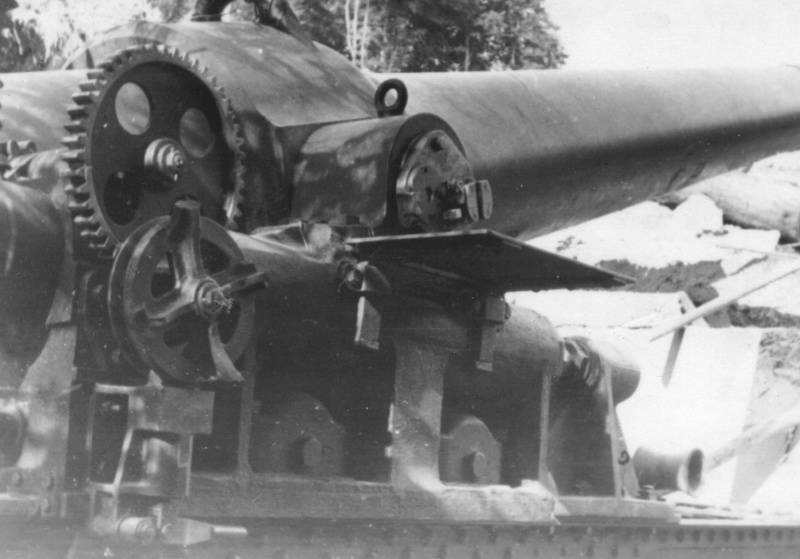
The lifting mechanism captured by the Germans of the French heavy 240-mm gun concern "Saint-Chamon" sample 84 / 17 of the year
The 400-mm caliber was also used by the railway gun, a French heavy cannon from the Saint-Chamon company, model 1916. The range of its shot was 16 km. The weight of the projectile was 900 kg. 406, 412 and 420-mm are caliber sea monster shells with barrels weighing more than 100 tons! An experienced 406-mm cannon is still standing on the range near St. Petersburg and our post-war self-propelled gun "Condenser" had the same caliber. 412-mm guns stood on the English battleship "Benbow". 420-mm - guns of the French battleship "Cayman" (1875 g.), And the German heavy field mortar "Big Bertha", which fired shells weighing 810 kg. It is also the caliber of the Soviet post-war self-propelled mortar "Oka". The 450-mm guns were the main caliber of the Italian battleships "Duilio" and "Dandolo". Finally, the 457-mm guns of the Japanese battleship Yamato (and Musashi of the same type with it), which had nine pieces on it, were the largest in terms of weight: a kind of record and now not beaten by any other country in the world. But these are not the largest weapons. An even larger caliber equal to 508-mm had guns of American monitors of the period of the American Civil War. And they sent to the target kernels weighing 500 kg. They were lifted by a special crane installed inside the tower, with the ears cast on their case, and they were rolled inside a special tray inserted into the barrel. The impact force of such nuclei was truly monstrous, they just made them from cast iron, therefore, hitting a sufficiently strong armor, they often simply broke, because of which they were abandoned in favor of projectiles with a pointed head.
On land, larger caliber guns also existed abound. For example, back in 1489, in Flanders, a 495-mm Mons Meg cannon was manufactured, with an unscrewing charging chamber, but the mortar of the Rhodes Knights, also preserved to this day, was even more - 584-mm! No less powerful guns had in the XV century. and the opponents of the Christians of that time were Turks who fought with Constantinople, as well as with the knights of Malta. Thus, during his siege in 1453, a Hungarian caster Urban cast them a copper bombard of the caliber 610-mm, shooting stone cores weighing 328 kg. In 1480, during the siege of the island of Rhodes, the Turks used bombers in caliber already 890-mm. In response, the Knights of Rhodes managed to cast exactly the same caliber of the Pumhard mortar, which threw its stone cores up sharply, which was more convenient for Europeans, while the Turks had to shoot from the bottom up. This also includes our legendary Tsar Cannon, which had an initial bore diameter of 900-mm, and the final one, next to a very narrow charging chamber, was 825-mm!
But the largest cannon (and not the bombard!) Was cast on the orders of Indian Rajah Gopola in 1670. By caliber, it is, however, inferior to the “Tsar Cannon”, but surpasses it in weight and length of the bore! The German self-propelled gun "Karl" originally had a caliber of 600-mm, but after the first trunks became unusable, they were replaced with new 540-millimeter. The famous "super gun" "Dora" had a caliber of 800-mm and was a giant railway transporter with its own bakery and bath, not to mention the means of air defense. But still it was not the largest ground weapon, but the American installation "Little David" in 914-mm caliber. Initially, it was used for the experimental throwing of aerial bombs, during their tests it replaced the bomber. At the end of the war, they tried to use it to destroy Japanese ground fortifications, but the war managed to end earlier than this idea actually worked.
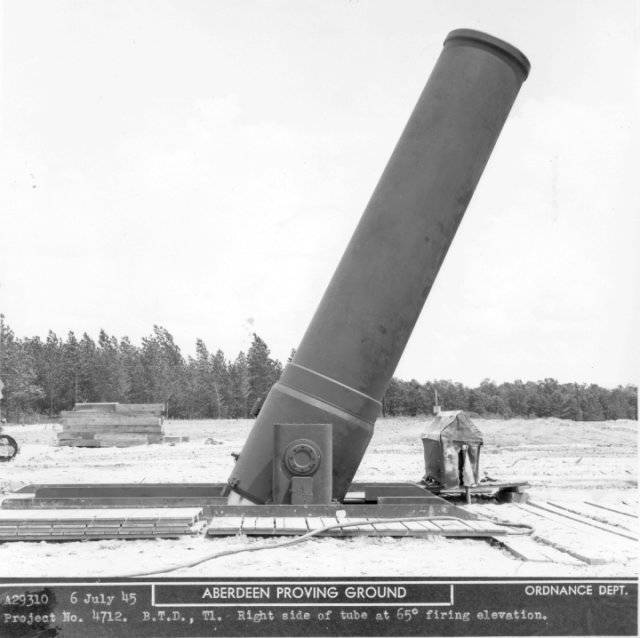
"Little David" 914-mm caliber
However, this gun is not the biggest in diameter of the bore! The most large-caliber is considered the mortar of the Englishman Robert Mallet of the 920-mm caliber, created back in the 1857 year. And, by the way, either! Indeed, in the Jules Verne novel “Five Hundred Million Begumy” a much more monstrous cannon is described, with one shot of which the wicked professor Schulze intended to destroy the whole city of Franceville. And although this is not the best of Jules Vernovsky novels, the gun in the Bull Tower is described in it in sufficient detail and competently. And, nevertheless, this is after all a fiction, but the “Little David” can be personally seen on the open site of the Aberdeen training ground in the USA.
Interestingly, during the Second World War, so-called bikaliber guns appeared, that is, guns with a tapered bore. At the entrance to it, the caliber was one, but at the exit the other was smaller! They used the "principle of Gerlich": when a conical barrel compresses the bullet to a slightly smaller diameter. In this case, the pressure of gases on its bottom increases, and the initial velocity and energy increase. A typical representative of such weapons systems was the German 28 / 20-mm (28-mm at the entrance to the cone, and the 20-mm at the muzzle cut) anti-tank gun. With the weight of the gun itself 229 kg, its armor-piercing projectile had a speed 1400 m / s, which was an order of magnitude higher than at that time gave other similar guns. But such an achievement went to the Germans at a high price. Conical trunks were difficult to produce, and they wore out much faster. Shells for them are also much more complicated, but they hold smaller explosives than conventional caliber ones. That is why in the end they had to abandon them, although some of them even participated in the battles.
Most likely, this is not a complete list, however, for the withdrawal is sufficient. And what is the conclusion? Only the fact that almost any "hole in the pipe" can be made shooting, there would be only a desire! After all, the same Japanese, for example, made guns out of tree trunks at all, even in the 1905 year, and from them they fired, although, of course, not with cores, but with incendiary projectiles from segments of bamboo trunks.
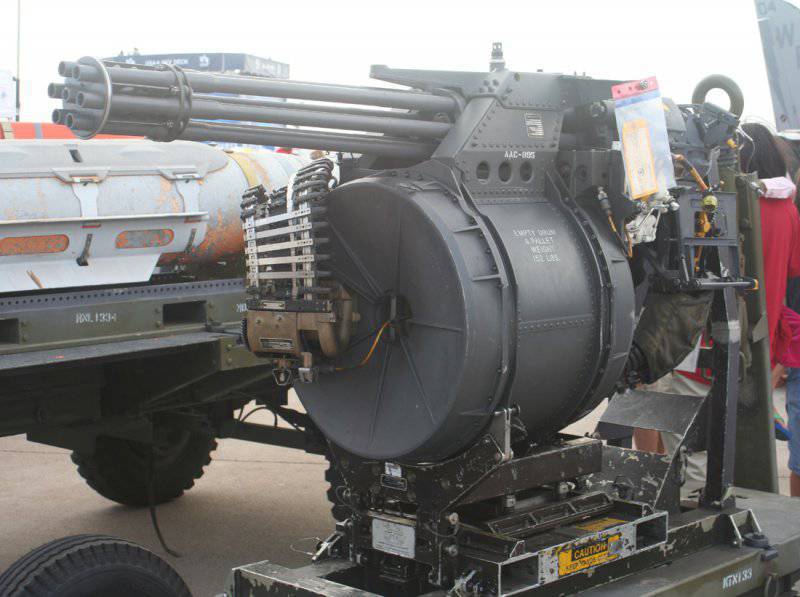
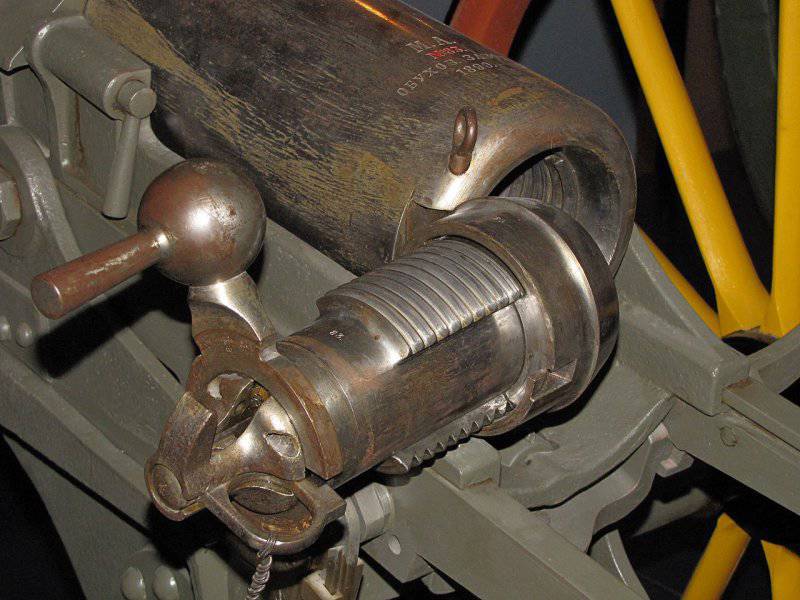
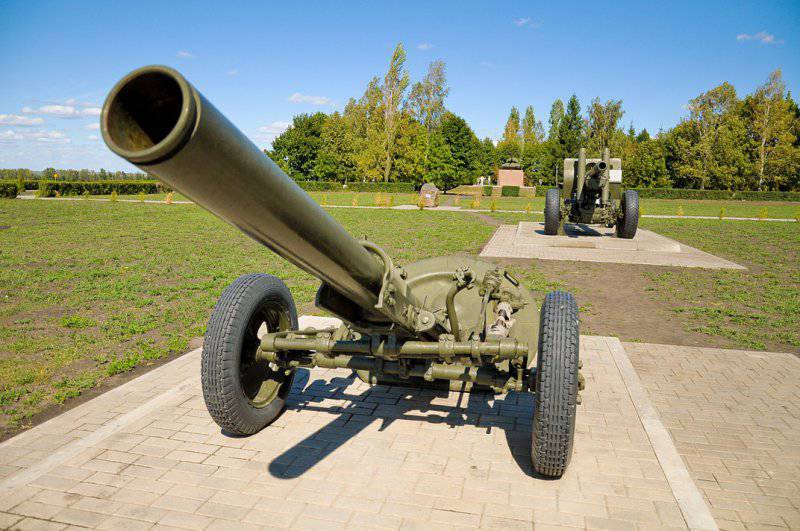
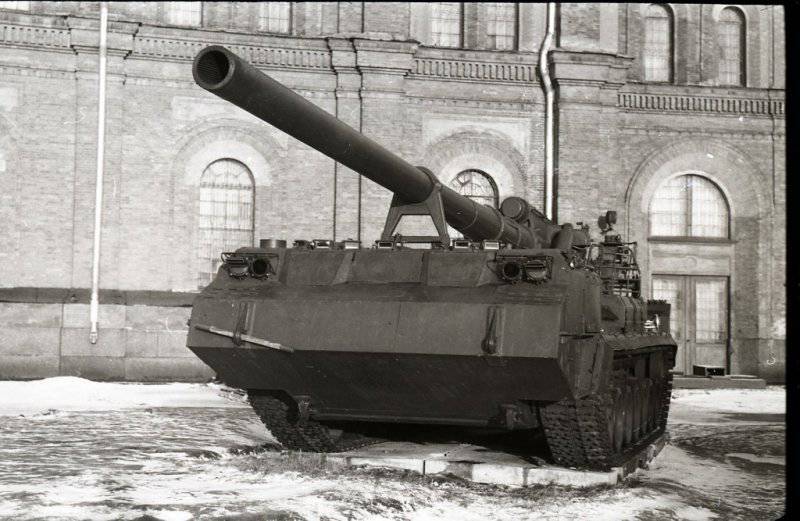
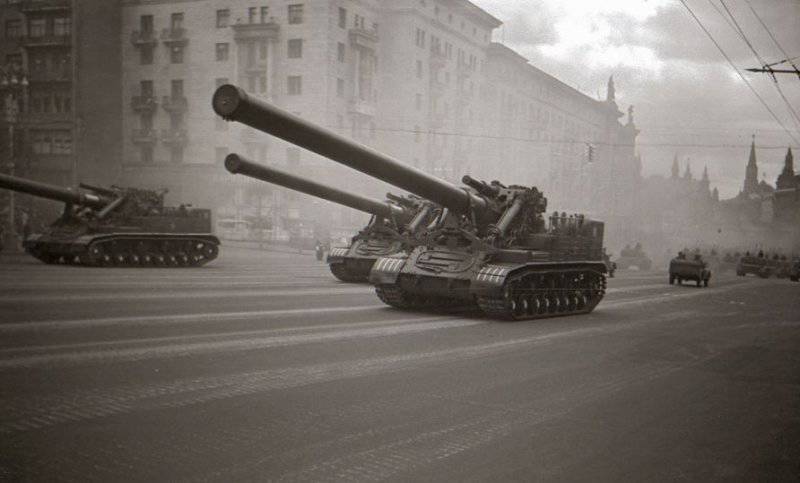
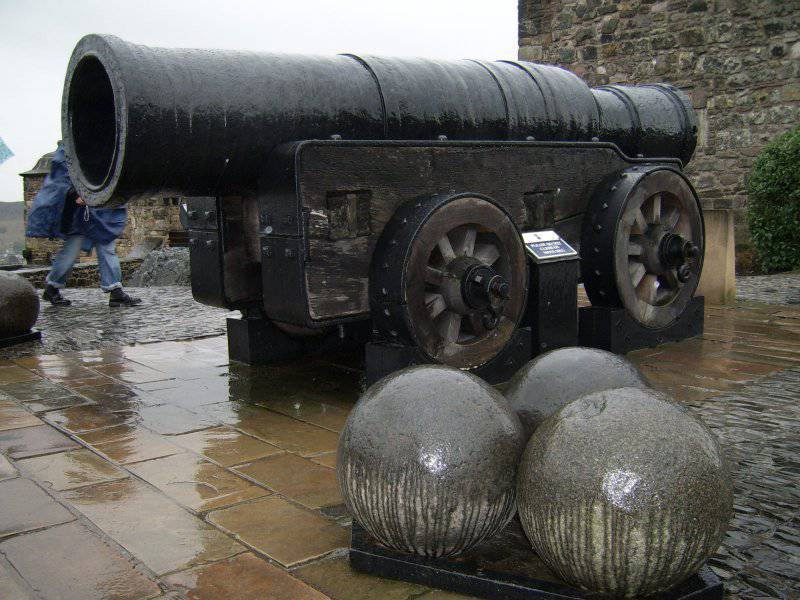
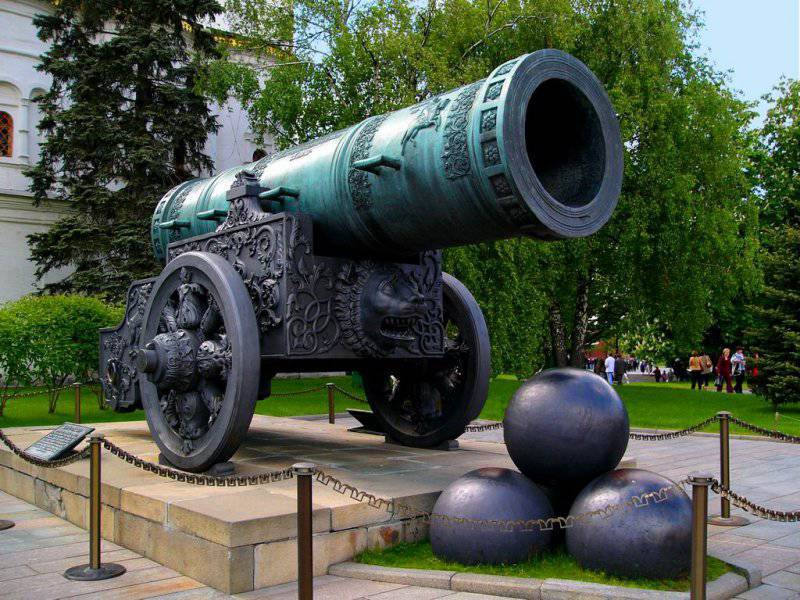
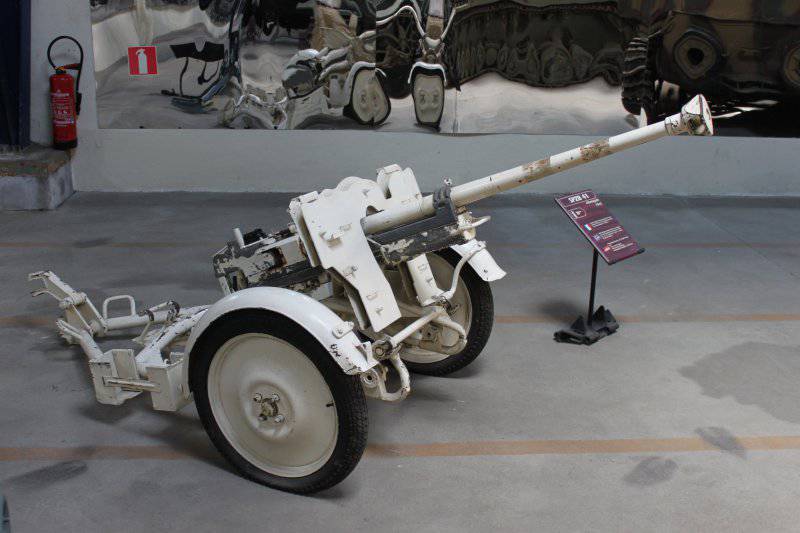
Information